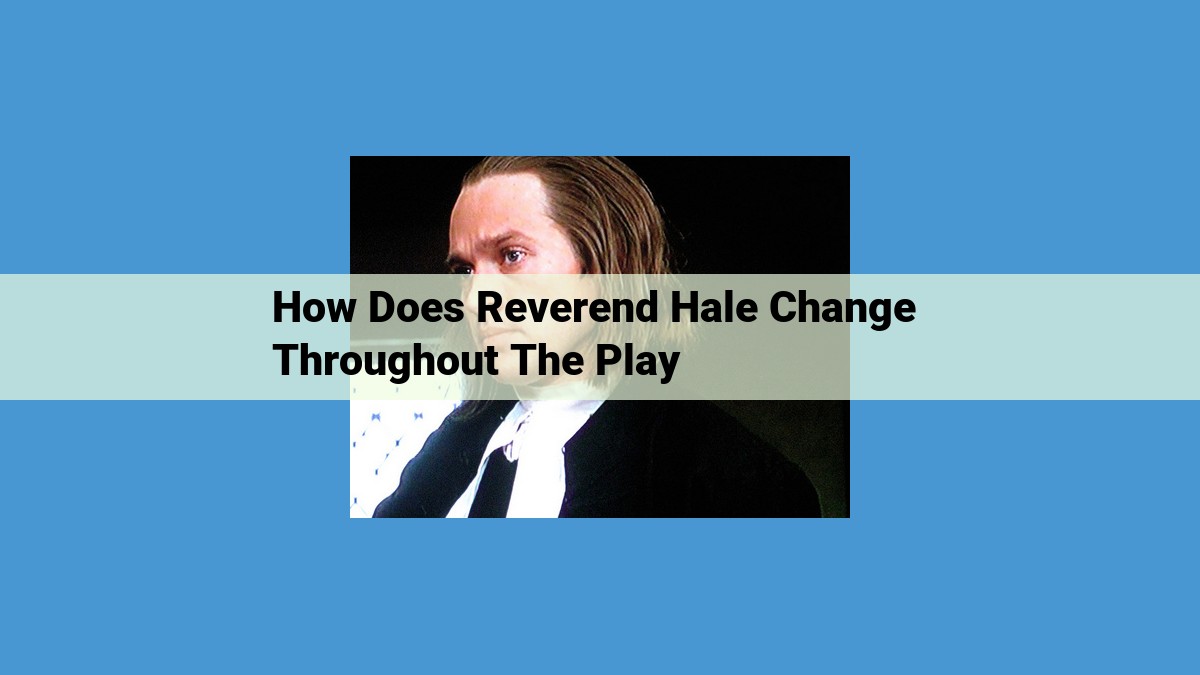Reverend Hale’s transformation unfolds as his preconceived prejudice and accusations confront evidence that challenges his beliefs. The cognitive dissonance leads to doubt, guilt, and moral conflict. Ultimately, he acknowledges his responsibility, abandons his biased assumptions, and advocates for the falsely accused, seeking atonement and justice.
Preconceived Prejudice and Blinding Accusations: John Hale’s Arrival and Rigid Beliefs
In Arthur Miller’s haunting play, The Crucible, Reverend John Hale arrives in Salem with an unshakeable conviction in his belief in witchcraft. His preconceived notions and rigid assumptions about the supernatural shape his every interaction with the townsfolk and fuel the paranoia that grips the community.
Hale’s arrival marks the beginning of a witch hunt, a tragic chain of events driven by prejudice and discrimination. His biased assumptions about certain individuals, particularly those on the fringes of society, lead to unjust accusations. These accusations are based not on evidence but on stereotypical beliefs and a lack of understanding. As a result, innocent lives are torn apart, and the true nature of evil remains hidden.
The Cognitive Dissonance of Doubt: Reverend Hale’s Journey
In Arthur Miller’s classic play, The Crucible, Reverend Hale arrives in Salem with preconceived notions about witchcraft, shaped by his rigid beliefs and biased assumptions. However, as he delves deeper into the accusations, he encounters evidence that challenges his preconceptions, triggering a profound cognitive dissonance.
Confronting Discrepancies
Hale’s critical thinking and self-reflection lead him to question the validity of his beliefs. He witnesses the contradictions in the testimonies and the lack of substantial evidence to support the accusations. The discrepancies between what he observes and what he has always believed create a sense of unease within him.
Wrestling with Doubts
As Hale grapples with his doubts, he begins to acknowledge the suffering that his actions have caused. He recognizes the injustice of the accusations and the guilt that weighs on his conscience. The cognitive dissonance he experiences becomes a catalyst for change.
Conflicting Beliefs, Guilt, and Confusion:
- Cognitive dissonance creates ambivalence and moral conflict.
- Hale acknowledges the suffering his actions have caused.
Conflicting Beliefs, Guilt, and Confusion: Reverend Hale’s Inner Turmoil
As evidence mounts, challenging Reverend Hale’s unwavering belief in witchcraft, he experiences a profound cognitive dissonance. The dissonance arises from the clash between his preconceived notions and the reality he encounters in Salem.
Amidst the chaos and accusations, Hale grapples with ambivalence and moral conflict. The realization that his actions have inflicted immense suffering upon innocent individuals weighs heavily on his conscience. He can no longer turn a blind eye to the injustice that has taken root in his community.
The guilt that gnaws at Hale’s heart stems from the realization that he has been complicit in the witch hunt. The anguish he witnesses – the imprisonment, the cries of the accused – torments him. He cannot shake the sense that he has allowed himself to become a tool of oppression.
Navigating the Moral Maze
Hale’s transformation is a testament to the power of self-reflection and critical thinking. He embarks on a journey to reconcile his conflicting beliefs, seeking to reclaim his moral integrity. Through empathy and a newfound understanding of the human condition, Hale recognizes the profound damage his actions have caused.
Embracing Accountability and Justice
Driven by remorse and a deep desire for atonement, Hale emerges as an advocate for justice. He realizes that he must use his voice and influence to right the wrongs that have been committed. His transformation signifies a shift from blind adherence to preconceived ideas towards a path of accountability and compassion.
Acceptance of Responsibility and Advocacy for Justice: Reverend Hale’s Transformative Journey
Guided by Empathy and Remorse
Reverend Hale’s cognitive dissonance gradually crumbles as he witnesses the suffering and injustice inflicted upon the accused. The trials’ preconceived prejudices and blinding accusations weigh heavily on his conscience, stirring within him a deep sense of empathy and remorse. Hale realizes the devastating consequences of his own prejudice and the tragic mistakes he has made.
Seeking Atonement through Advocacy
Haunted by his past actions, Hale resolves to atone for his role in the witch trials. He recognizes that the only path to redemption lies in advocating for justice and protecting those who have been falsely accused. With newfound determination, Hale becomes an ardent defender of the innocent, using his voice and influence to challenge the hysteria and injustice that has gripped the community.
Reverend Hale’s journey in “The Crucible” serves as a powerful reminder of the corrosive effects of prejudice and the importance of critical thinking. His transformation from a blinded accuser to an advocate for justice highlights the power of empathy, remorse, and redemption. Through Hale’s story, Arthur Miller challenges us to question our own biases, to hold ourselves accountable for our actions, and to fight against injustice wherever it may arise.
